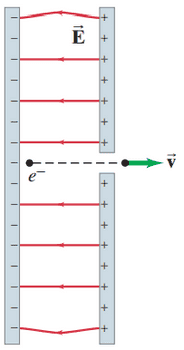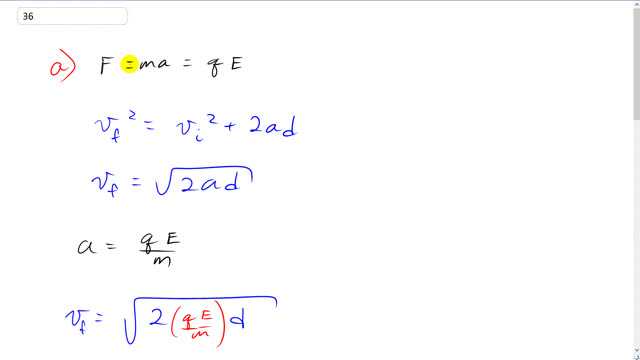
An electron mass is accelerated in the uniform field between two thin parallel charged plates. The separation of the plates is 1.60 cm. The electron is accelerated from rest near the negative plate and passes through a tiny hole in the positive plate, Fig. 16–61.
- With what speed does it leave the hole?
- Show that the gravitational force can be ignored.

- acceleration due to the electric field is times greater than that due to gravity. Gravity is negligible in comparison.

In order to watch this solution you need to have a subscription.
This is Giancoli Answers with Mr. Dychko. In part A, we'll assume that the only force is the electrostatic force, assuming that gravity is negligible which we'll demonstrate in part B. So in part A, since the electrostatic force we've seen is the only force, it's the net force, so it equals ma. This being the electrostatic force when you have a charge in the electric field E. The final velocity of this charge is gonna be its initial velocity squared plus two times acceleration times d. When you get the square root of both sides, and knowing that it starts at rest, you have final velocity as square root two ad. From this work up here, we can see that a is qE over m when you divide both sides by m, and then we can substitute that for a in our final velocity formula here. We get final velocity, square root two times the charge and the electric field divided by mass, times the separation between the plates. It's gonna be the square root of two times 1.6 times 10 to the minus 19 Coulombs charge in electron, times 1.45 times 10 to the four Newtons per Coulomb electric field strength, times 1.6 times 10 to the minus two meters separation between the plates, divided by 9.11 times 10 to minus 31 kilograms mass of an electron. Then we get 9.03 times 10 to the six meters per second. It's gonna be the final velocity. That's pretty darn fast. Now to compare the acceleration due to the electrostatic force with that of gravity, divide them and see if they were to factor they're different. We take the acceleration we figured out before, qE over m and divide that by g, and that's qE over mg. And plugging in numbers, we get 1.6 times 10 to the minus 19 Coulombs, times electric field, 1.45 times 10 to the four Newtons per Coulomb, divided by the mass of an electron and then times the gravitational field strength. Then we get about 2.6 times 10 the 14 as the factor by which they're different. The acceleration due to the electric field is 2.6 times 10 to the 14 times larger than the acceleration due to gravity, and so gravity is negligible.